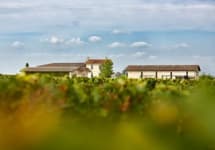Chateau Chauvin 2018
-
Jeb
Dunnuck -
Wilfred
Wong - Decanter
-
James
Suckling -
Robert
Parker



Product Details
Your Rating
Somm Note
Winemaker Notes
With precision and rigor, with respect for the terroir of Saint-Emilion and the conditions specific to each vintage, Sylvie Cazes and her team have created elegant, balanced, feminine, and classy wines with the potential for ageing.
Blend: 75% Merlot, 205 Cabernet Franc, 5% Cabernet Sauvignon
Professional Ratings
-
Jeb Dunnuck
Checking in as a mix of 85% Merlot, 12% Cabernet Franc, and 3% Cabernet Sauvignon brought up in 50% new oak, the 2018 Château Chauvin is a rich, powerful wine that clearly ranks with the finest wines from this address in the past decade or so. A dense purple hue is followed by awesome black raspberry and spiced cherry fruits as well as notes of chocolate, dried herbs, sandalwood, and tobacco. With full-bodied richness, a round, layered mouthfeel, and ripe yet certainly present tannins, it has some up-front appeal given its beautiful fruit and texture, yet it deserves 4-6 years in the cellar and will be a 20- to 25-year wine. Bravo!
-
Wilfred Wong of Wine.com
COMMENTARY: The 2018 Château Chauvin points to excellence in richness. TASTING NOTES: This wine exhibits aromas and flavors of intense ripe fruits from red to black and a nice balance of oak. Store it away for a few years before opening. (Tasted: November 10, 2021, San Francisco, CA)
-
Decanter
Savoury and fragrant as with Folie de Chauvin, but here with accompanying depth and power. Raspberry and blueberry fruits on the attack giving way to richer raspberry purée and black cherry through the mid palate, all given a firm lift through the finish. Enjoyable with touches of graphite and liquorice-laced tannins. Deepened over ageing. Drinking Window 2024 - 2040
-
James Suckling
Blackberries and cherries, violets, herbs and some ash character to this full-bodied St.-Emilion. Savory, chewy texture with tight tannins and a medium finish. Try after 2024.
-
Robert Parker's Wine Advocate
Deep garnet-purple in color, the 2018 Chauvin rolls effortlessly out of the glass with notions of spiced black plums, blackberry preserves and mulberries with hints of clove oil and incense. Medium to full-bodied, the palate delivers loads of juicy black fruit flavors with a soft texture and just enough freshness, finishing spicy.
Other Vintages
2022-
James
Suckling - Vinous
-
Jeb
Dunnuck - Decanter
-
Wine
Enthusiast -
James
Suckling - Decanter
-
Jeb
Dunnuck
-
Jeb
Dunnuck -
Robert
Parker -
Wine
Enthusiast -
James
Suckling - Decanter
-
James
Suckling -
Jeb
Dunnuck -
Wine
Enthusiast - Decanter
-
Robert
Parker
-
James
Suckling - Decanter
-
Jeb
Dunnuck -
Robert
Parker
-
James
Suckling -
Jeb
Dunnuck -
Wilfred
Wong -
Robert
Parker
-
Wine
Enthusiast -
James
Suckling
-
James
Suckling -
Robert
Parker
-
James
Suckling -
Wine
Spectator -
Robert
Parker
-
Wine
Spectator
-
Robert
Parker
-
Robert
Parker
-
Robert
Parker


We have been in partnership with BIOVITIS since 1994. Half of the vineyard is ploughed mechanically, while the other half is cultivated with grass-cover between the rows. Green harvesting is carried out throughout the vegetation cycle, to bring yields to 35 to 40 Hl/Ha.
At Chauvin the wine is made in the traditional way, while also making the most of what modernity has to offer: nothing is done systematically and each year every effort is focused on adapting the techniques to the qualities of that year's grapes.

One of the world’s most classic and popular styles of red wine, Bordeaux-inspired blends have spread from their homeland in France to nearly every corner of the New World. Typically based on either Cabernet Sauvignon or Merlot and supported by Cabernet Franc, Malbec and Petit Verdot, the best of these are densely hued, fragrant, full of fruit and boast a structure that begs for cellar time. Somm Secret—Blends from Bordeaux are generally earthier compared to those from the New World, which tend to be fruit-dominant.

Marked by its historic fortified village—perhaps the prettiest in all of Bordeaux, the St-Émilion appellation, along with its neighboring village of Pomerol, are leaders in quality on the Right Bank of Bordeaux. These Merlot-dominant red wines (complemented by various amounts of Cabernet Franc and/or Cabernet Sauvignon) remain some of the most admired and collected wines of the world.
St-Émilion has the longest history in wine production in Bordeaux—longer than the Left Bank—dating back to an 8th century monk named Saint Émilion who became a hermit in one of the many limestone caves scattered throughout the area.
Today St-Émilion is made up of hundreds of independent farmers dedicated to the same thing: growing Merlot and Cabernet Franc (and tiny amounts of Cabernet Sauvignon). While always roughly the same blend, the wines of St-Émilion vary considerably depending on the soil upon which they are grown—and the soils do vary considerably throughout the region.
The chateaux with the highest classification (Premier Grand Cru Classés) are on gravel-rich soils or steep, clay-limestone hillsides. There are only four given the highest rank, called Premier Grand Cru Classés A (Chateau Cheval Blanc, Ausone, Angélus, Pavie) and 14 are Premier Grand Cru Classés B. Much of the rest of the vineyards in the appellation are on flatter land where the soils are a mix of gravel, sand and alluvial matter.
Great wines from St-Émilion will be deep in color, and might have characteristics of blackberry liqueur, black raspberry, licorice, chocolate, grilled meat, earth or truffles. They will be bold, layered and lush.
